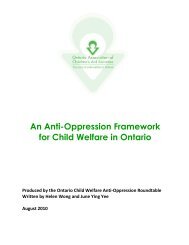English - Ontario Association of Children's Aid Societies
English - Ontario Association of Children's Aid Societies
English - Ontario Association of Children's Aid Societies
You also want an ePaper? Increase the reach of your titles
YUMPU automatically turns print PDFs into web optimized ePapers that Google loves.
F. PRACTICE: ENGAGE OTHERS TO SUPPORT THE FAMILY<br />
Creating positive changes requires the involvement <strong>of</strong> many service providers<br />
working collaboratively to support the family. Collaborative partnerships might<br />
include the VAW sector or Aboriginal community organizations.<br />
Focus group participants noted that they contacted child welfare because they had<br />
exhausted all available resources, and hoped that CAS might be able to assist their<br />
children during the difficult periods — not because they did not wish to parent. This<br />
is something that many felt CAS had misunderstood about them.<br />
PRACTICE TIP<br />
Establish a relationship with an<br />
Aboriginal organization who will work<br />
with the family in a non threatening<br />
way. Including other service providers<br />
can help to support your work and help<br />
to support the family in their safety<br />
planning and identifying family needs.<br />
> > One mother called CAS because she moved down<br />
from the north, had no family and friends and<br />
needed help as she was sick and going on new<br />
medication. She said, “I don’t like CAS but I need<br />
help.” In her dealings with CAS, she had to prove<br />
her competence as a parent. She was not an<br />
incompetent parent, she was just sick and isolated.<br />
> > Another mother had a 14-year-old who had an<br />
addiction and needed help. CAS apprehended him<br />
and put him into a foster home but not into<br />
treatment. He only received treatment once he<br />
was 16 and out <strong>of</strong> the CAS system.<br />
“A lot <strong>of</strong> people think nobody loves<br />
USE THE HARMONY CIRCLES<br />
them at all, especially if they lose their<br />
parents or close relatives: they start<br />
In the Harmony Circle model <strong>of</strong> care, children<br />
thinking no one cares but, in reality,<br />
belong to a family, and the child and family in<br />
people do care and love them, but they<br />
turn belong to a community. If the Harmony<br />
don’t know it and it is ruining their<br />
Circle model is used, then it is important to use<br />
lives. They have to realize other people<br />
interventions that reinforce connection between<br />
do love them and care for them. We<br />
the family, extended family and community. The<br />
have to make the person aware <strong>of</strong> this.”<br />
Harmony Circle approach establishes a circle <strong>of</strong><br />
care around each family. Looking to the extended<br />
- Elder from Repulse Bay<br />
family and community for resources, Customary<br />
Care or kinship care are among the first options to<br />
explore if children cannot stay with their parents. A<br />
key task for child welfare pr<strong>of</strong>essionals is to encourage a collaborative approach and<br />
help to connect the circles (child/family/community/nation) to regain balance and<br />
maintain relationships.<br />
CONNECT WITH THE COMMUNITY<br />
106<br />
The Inuit, Métis and First Nations Liaison Group <strong>of</strong> the Children’s <strong>Aid</strong> Society <strong>of</strong><br />
Ottawa has found that a community approach that brings Aboriginal community<br />
organizations (that can relate to the families, know their stories and know the<br />
challenges and appropriate strategies to develop resiliency) together with CAS is<br />
effective.

















